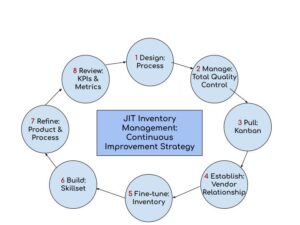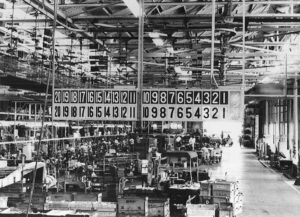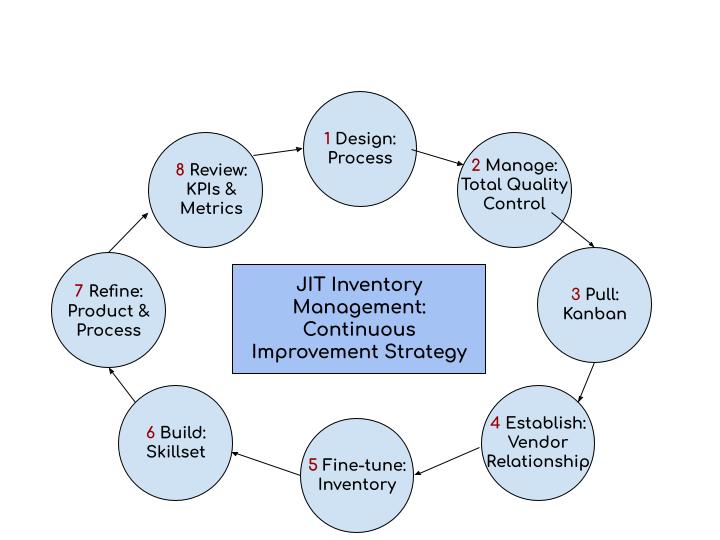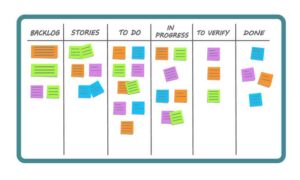12/06/2023
‘Just-in-time inventory management’, ‘just-in-time manufacturing’, ‘kaizen’, ‘continuous improvement’, and ‘lean’ are buzzwords that one tends to hear a lot in the supply chain world. Many of these terms tie into emerging concepts of manufacturing and inventory management to boost profitability. The demands of today’s competitive economic landscape are much higher than before, and businesses have to adapt to keep up.
In this article, we will be taking an in-depth look at just-in-time inventory management.
What is Just-in-Time Inventory Management?
Just-in-time (JIT) inventory management is an inventory control system that aims to deliver materials or components to the production line precisely when they are required. It is based on the principle of producing and delivering goods or services in response to customer demand, rather than stockpiling excess inventory.
The primary objective of JIT is the increased focus on eliminating waste, reducing lead times, and optimizing the flow of materials throughout the supply chain. This results in enhancing operational efficiency, minimizing costs, and improving customer satisfaction.
An essential element of just-in-time is having long-term contracts with reliable suppliers. All the parts of the system are intricately interconnected and mutually dependent for successful operation.
Steps in the Cycle of Continuous Improvement for Just-in-Time Inventory
Every business that implements just-in-time inventory management, though varying in implementation, follows a general pattern of JIT procedures to achieve the results.
Design: The ideation of foundational processes happens at this stage. These include product design, manufacturing planning, process design, and personnel.
Manage: Continuous improvement is central to the process of JIT. At this stage, management defines the job roles of employees, sets parameters for quality control, and looks at load and capacity levels and schedules.
Pull: Keeping the team informed on the methods of production and withdrawal using Kanban or similar signaling methods, reviewing policies on lot sizes, and aiming to reduce wastage.
Establish: At this stage, the business should look over vendor relationships, contract negotiations, lead times, delivery expectations, preferred suppliers, and usage metrics.
Fine-tune: Reducing inventory movement as much as possible and determining the policies and controls on inventory.
Build: Detailing the skills required to make the process work and educating employees accordingly
Refine: Reducing the steps in production by refining the processes.
Review: Defining the metrics of quality and analyzing problem areas to identify root causes of problems. Tracking trends and improving on each aspect of JIT.

The Continuous Improvement Cycle
Techniques Involved in Just-in-Time Inventory
There are several techniques and strategies involved in just-in-time inventory management methodology. For example, focused activities like paying attention to minute details, smaller lot sizes, increased transparency, optimized organization and a ‘pull’ as opposed to a ‘push’ approach are all facets of the lean method of operation, and essential parts for running a successful just-in-time inventory management warehouse.
I. Streamlined Supply Chain Processes:
– Collaborative relationships with suppliers
– Regular communication to ensure timely deliveries
– Continuous improvement of supply chain processes
II. Accurate Demand Forecasting:
– Utilizing historical data and market trends
– Monitoring sales patterns and customer preferences
– Employing advanced forecasting methods and tools
III. Lean Manufacturing Practices:
– Eliminating waste and non-value-added activities
– Implementing efficient production systems, such as Kanban or continuous flow
– Adopting a pull-based production approach driven by customer demand
IV. Efficient Inventory Control:
– Setting optimum inventory levels based on demand and lead times
– Implementing real-time inventory tracking systems
– Regularly reviewing inventory turnover ratios
V. Quick Response to Customer Orders:
– Minimizing order processing and lead times
– Prioritizing agile and flexible production processes
– Utilizing advanced order management systems
VI. Cross-Functional Collaboration:
– Aligning departments to work in harmony
– Facilitating communication between production, sales, and logistics teams
– Encouraging teamwork and knowledge sharing
VII. Continuous Improvement:
– Regularly assessing and optimizing processes
– Encouraging employee involvement in identifying areas for improvement
– Implementing Kaizen principles to drive ongoing enhancements
VIII. Quality Management:
– Implementing strict quality control measures
– Conducting inspections and quality checks at every stage
– Engaging in continuous quality improvement initiatives
IX. Risk Management:
– Developing contingency plans for supply chain disruptions
– Building alternative supplier relationships
– Implementing buffer stock strategies for critical components
X. Technological Integration:
– Utilizing inventory management software and systems
– Automating processes and data collection
– Employing advanced analytics for demand forecasting and inventory optimization
A terminology frequently used in just-in-time inventory management is the Japanese ‘Kanban’, meaning ‘sign’ or ‘visual board’. This concept is central to JIT.
What is ‘Kanban’ and why is it crucial for lean JIT inventory?
Kanban can be defined as the CPU of the entire JIT operations, where work-in-progress and inventory movement is controlled. It is critical for eliminating the waste that results from overproduction.
Traditional mass production systems use the push method and produce according to the forecasted sales. The Kanban system allows for greater flexibility on the production floor since production is based on actual orders. The production progress on the factory floor is tracked using cards (digital or paper). Kanban cards reflect the movement of inventory through the production process and can signal when it’s time to order more stock.
Example of a Kanban Board
The Benefits of Just-in-Time Inventory Management:
- Reduced Inventory Costs:
- JIT enables businesses to minimize holding and storage costs associated with excess inventory.
- By ordering and producing materials only when needed, companies can significantly reduce inventory levels, freeing up capital for other investments.
- Lower inventory levels also result in reduced warehouse space requirements, leading to potential cost savings.
- Enhanced Efficiency and Productivity:
- JIT encourages a smooth and continuous flow of materials, ensuring that production processes are not interrupted by inventory shortages or excesses.
- This streamlined approach helps in identifying bottlenecks and inefficiencies, enabling timely adjustments and process improvements.
- JIT also fosters a culture of continuous improvement, as any waste or inefficiency is immediately noticeable and can be addressed promptly.
- Improved Quality Control:
- With JIT, materials are received just in time for production, reducing the chances of inventory becoming obsolete or damaged over time.
- By maintaining lower inventory levels, businesses can focus on ensuring the quality and integrity of the incoming materials, reducing the risk of defects or spoilage.
- JIT facilitates the implementation of rigorous quality control measures, as there is a greater emphasis on inspection and monitoring of incoming supplies.
- Faster Response to Customer Demand:
- JIT allows businesses to be more responsive to changing customer demands and market trends.
- With a reduced lead time for ordering and production, companies can quickly adapt to shifts in customer preferences or market conditions.
- This agility in response to customer demand can lead to improved customer satisfaction and increased market competitiveness.
Disadvantages of JIT Inventory Management
The JIT philosophy depends on the diligence of everyone involved in the ecosystem to perform their duties in a timely and cohesive manner. The moment any part of this structure begins to sway, the whole infrastructure is jeopardized.
Several risks could endanger the seamless functioning of a JIT inventory management system:
Lack of Preparation: Since the entire workflow of the business needs to convert to lean management, being prepared is essential. It means that all procedures and practices of the firm need to accommodate the lean methodology.
Missed opportunities: Since JIT means that there are few or no finished goods available on hand, large or unexpected orders can become huge missed opportunities.
Order Issues: Stockouts and shortages can disrupt the entire system.
Undisciplined employees: If every team member is not on board with the idea of JIT and does not perform their due diligence, the quality of goods and productivity can be affected.
Natural Disasters: Acts of nature that are out of our control can interfere with the flow of goods and inhibit the production process.
Supplier inconsistencies: If there are issues with suppliers like untimely delivery or inaccurate amounts, then the entire production process can be disrupted.
History of JIT
Just-in-time inventory management emerged in the 1970s, closely intertwined with the development of the Toyota Production System (TPS), which served as its foundation. The origins of JIT can be traced back to post-World War II Japan. Japan faced significant economic challenges during this period and needed to find innovative ways to rebuild its industries. The Toyota Motor Corporation, under the leadership of Taiichi Ohno and Eiji Toyoda, recognized the need for a more efficient production system to compete with international manufacturers.

Toyota Production Floor in the 1960s
In the 1950s, Toyota began to explore alternatives to traditional mass production systems, which involved large inventories and long lead times. The company studied the production methods of American supermarkets, where goods were restocked based on actual customer demand rather than anticipated demand. This observation inspired Toyota to develop a production system that aligned manufacturing with customer requirements while minimizing overproduction.
The Toyota Production System, better known as Lean Manufacturing, focuses on eliminating different types of wastages, like excess inventory. It focused on achieving a smooth, continuous flow of materials and information throughout the production process. The core idea behind JIT was to produce and deliver items just in time to meet customer demand, thereby reducing inventory levels and associated costs.
JIT gained international recognition and popularity in the 1980s. JIT principles, including just-in-time delivery, vendor-managed inventory, and continuous improvement, were applied to a wide range of industries beyond automotive manufacturing.
Over time, the concept of JIT has evolved and adapted to changing business environments. New technologies and digital solutions have enabled more accurate demand forecasting, improved supply chain visibility, and enhanced collaboration between supply chain partners. Additionally, concepts like lean manufacturing and Six Sigma have been integrated with JIT to achieve further efficiencies and quality improvements.
Examples of JIT Inventory Management
Just-in-Time (JIT) inventory management is a widely adopted approach across various industry verticals.
-
Automotive Industry:
The automotive sector is one of the pioneers in implementing JIT-based inventory management. Companies like Toyota, Honda, and Ford have successfully embraced JIT principles to streamline their supply chains and improve production efficiency. By maintaining minimal inventory levels and relying on timely deliveries, these companies have reduced costs and responded quickly to changing market dynamics.
-
Electronics Industry:
In the fast-paced electronics industry, companies face rapid technological advancements and shorter product life cycles. JIT-based inventory management helps them adapt to these challenges effectively. Apple, Samsung, and Sony have been known to implement JIT techniques.
In the case of Apple, they have one central warehouse located in the USA and about 150 suppliers around the world. They have robust and strategic relationships with all their vendors. Outsourcing production contributed to making Apple leaner, with most inventory in retail outlets and very little overstock.
-
Retail Industry:
Retailers, both traditional and e-commerce, have recognized the advantages of JIT inventory management. Companies like Walmart, Amazon, and Zara have successfully employed JIT.
Amazon implements a variation of JIT by setting up dedicated spaces inside the warehouses of their major suppliers. Inside the Pennsylvania warehouse of Procter & Gamble (P&G), Amazon has a fenced-off area where P&G can simply move pallets. Employees from Amazon package, label and ship those directly to consumers. Since this facility is very close to P&G’s largest manufacturing plant and close to many major cities in the US and Canada, Amazon can meet its 24-hour delivery period on the personal care products of P&G.
-
Pharmaceutical Industry:
The pharmaceutical sector has unique inventory management requirements due to product expiration dates, stringent regulations, and varying demand patterns. JIT-based inventory management helps pharmaceutical companies like Pfizer, Johnson & Johnson, and Novartis in minimizing inventory holding costs, avoiding product obsolescence, and ensuring the timely availability of critical medicines.
-
Food and Beverage Industry:
Freshness and quality are crucial in the food and beverage industry. JIT-based inventory management enables companies in this sector to reduce food waste, manage perishable items efficiently, and maintain optimal inventory levels, sometimes using techniques like consignment inventory. Fast-food chains like McDonald’s and restaurant groups like Darden Restaurants have implemented JIT techniques to ensure that the right ingredients are available at the right time.
Another example is Kellogg’s, which has implemented JIT in production, inventory, distribution, and operations. They obtain raw food materials from suppliers all over the globe and use JIT to optimize production, inventory costs, and budgets.
-
Aerospace Industry:
The aerospace industry requires precise coordination and synchronization of various components to meet stringent production schedules. Companies like Boeing and Airbus have implemented JIT inventory management to ensure the timely delivery of aircraft parts and streamline their complex supply chains.
Boeing took the initiative in the 1990s to apply JIT across their supply chain. The decision was made to work more closely with suppliers and remove redundancies, improve quality, and reduce costs. They rely heavily on their supply base to meet customer demand. They implement lean manufacturing and work as integrators of large parts and systems.
-
Apparel and Fashion Industry:
In the fast-changing world of fashion, staying ahead of trends and minimizing inventory risk is crucial. Companies like Nike, Adidas, and H&M have adopted JIT inventory management to optimize their production and distribution processes by keeping inventory levels low and leveraging real-time data.
Zara, for example, is a company that operates on the principle that inventory equals death. Stocking apparel is costly and risky since the variety of styles, sizes, and colors require more inventory. Therefore, these fast fashion leaders are incredibly quick in bringing goods to market, and they own their entire supply chain. Fifty to sixty percent of their product line is locked in at the start of a season, i.e., manufacturing and design of up to fifty percent of their clothes happen in the middle of the season. If a particular design suddenly starts trending, Zara reacts by creating new products and designs and getting them into the market before the trend reaches its peak.
Nike has utilized JIT to improve their disconnected production facilities all over Southeast Asia. It resulted in cutting lead times, increasing productivity, and faster introduction of new models.
-
Medical Equipment Industry:
Manufacturers of medical equipment and devices face the challenge of managing a diverse range of products with varying demand patterns. JIT inventory management enables companies like Siemens Healthineers, GE Healthcare, and Medtronic to maintain optimal inventory levels, minimize carrying costs, and ensure the availability of critical medical equipment when needed.
Should my business implement JIT Inventory Management?
Before implementing the JIT Inventory Management system, there are several factors a business must consider. We have boiled these down to six basic questions that can help make your decision:
How quickly can the products be manufactured or supplied?
Turnaround time is a crucial consideration before converting to JIT.
How accurate is the demand forecasting?
There needs to be enough confidence in the sales forecasts, that they can depict demand fluctuations and seasonality.
Is the supply chain flexible enough?
In the event of unforeseen circumstances like natural disasters or supplier disruptions, the system should be able to adapt.
How efficient is the order fulfillment system?
The suppliers need to be reliable enough to deliver on time, every single time; and the order fulfillment system must be incredibly efficient – enough to cover up for delays.
Is the workforce up to the task?
Every operational division has to be in sync for a JIT system to function effectively. Employees need to be cross-functionally trained so they can fill in at different points as and when needed.
Is my technology infrastructure prepared?
To keep track and manage everything efficiently, the right software support is required.
The entire organization needs to be prepared to convert to JIT, and you can gauge the readiness of your business by considering the aforementioned six major factors: turnarounds, vendors, flexibility, technology, forecasting, and workforce. A warehouse management system to keep an eye on the movement of stock can help with the implementation of JIT inventory management.
The bottom line is that while JIT has its pros and cons, there has been historical evidence that businesses that implement JIT successfully reap the benefits of cost savings, better quality control, and waste reduction.
JIT Inventory Management Frequently Asked Questions (FAQs)
It can be difficult to understand all the terminology and implementation procedures for JIT all at once. Here we have a summary and FAQs section.
What is JIT inventory management?
JIT (Just-in-Time) inventory management is a strategy where businesses aim to minimize inventory levels by receiving goods and materials exactly when they are needed in the production process.
What are the potential benefits of implementing JIT inventory management?
Implementing JIT inventory management can lead to reduced inventory carrying costs, improved cash flow, minimized storage space requirements, decreased waste, and increased overall efficiency.
Is JIT inventory management suitable for all businesses?
JIT inventory management is not suitable for all businesses. It works best for companies that have stable demand, reliable suppliers, and efficient production processes. Businesses with highly variable demand or unreliable suppliers may face challenges in implementing JIT effectively.
What are the potential risks of implementing JIT inventory management?
Some potential risks or drawbacks of implementing JIT inventory management include the risk of supply chain disruptions, reliance on a limited number of suppliers, increased vulnerability to demand fluctuations, and potential production delays if the supply chain is not reliable.
What factors should a business consider before implementing JIT inventory management?
Businesses should consider factors such as demand predictability, supplier reliability, production process efficiency, the cost of implementing JIT, potential risks, and the overall compatibility of their operations with JIT principles before deciding to implement JIT inventory management.
Are there any alternative inventory management strategies to JIT?
Yes, there are alternative inventory management strategies to JIT, such as the Economic Order Quantity (EOQ) model, Material Requirements Planning (MRP), and Vendor Managed Inventory (VMI). These strategies may be more suitable for businesses with specific needs or characteristics that are not well-aligned with JIT principles.
What’s the difference between JIT inventory and JIT manufacturing?
The major difference between JIT inventory and manufacturing is their point of contact in the supply chain. JIT manufacturing works on the principle of producing a product only when needed, and JIT inventory applies the same principle to receiving products in the warehouse. They can work together or independently.
What is the difference between just-in-time inventory vs. Economic Order Quantity (EOQ)?
Economic Order Quantity (EOQ) is a formula for identifying stock replenishment levels. Favorable inventory items are regulated to reduce storage and order costs. It is typically useful when order, holding and demand costs remain consistent over time.
JIT aims to ensure that the right quantity and quality of inventory is stocked while minimizing the wastage of resources, time, and material.
What is the difference between just-in-time vs. just-in-case (JIC) manufacturing?
JIT manufacturing is when products are produced only when needed, based on customer demand, to prevent overproduction and reduce wastage. On the other hand, surplus goods are stocked in JIC manufacturing, so that the current demand can be outpaced and orders are fulfilled on time.
What is the application of the Theory of Constraints (TOC) in JIT?
The Theory of Constraints in JIT is a principle used to pinpoint systemic weaknesses and variables that may be constraining throughput.
References
https://www.sciencedirect.com/science/article/pii/027269639500011G







